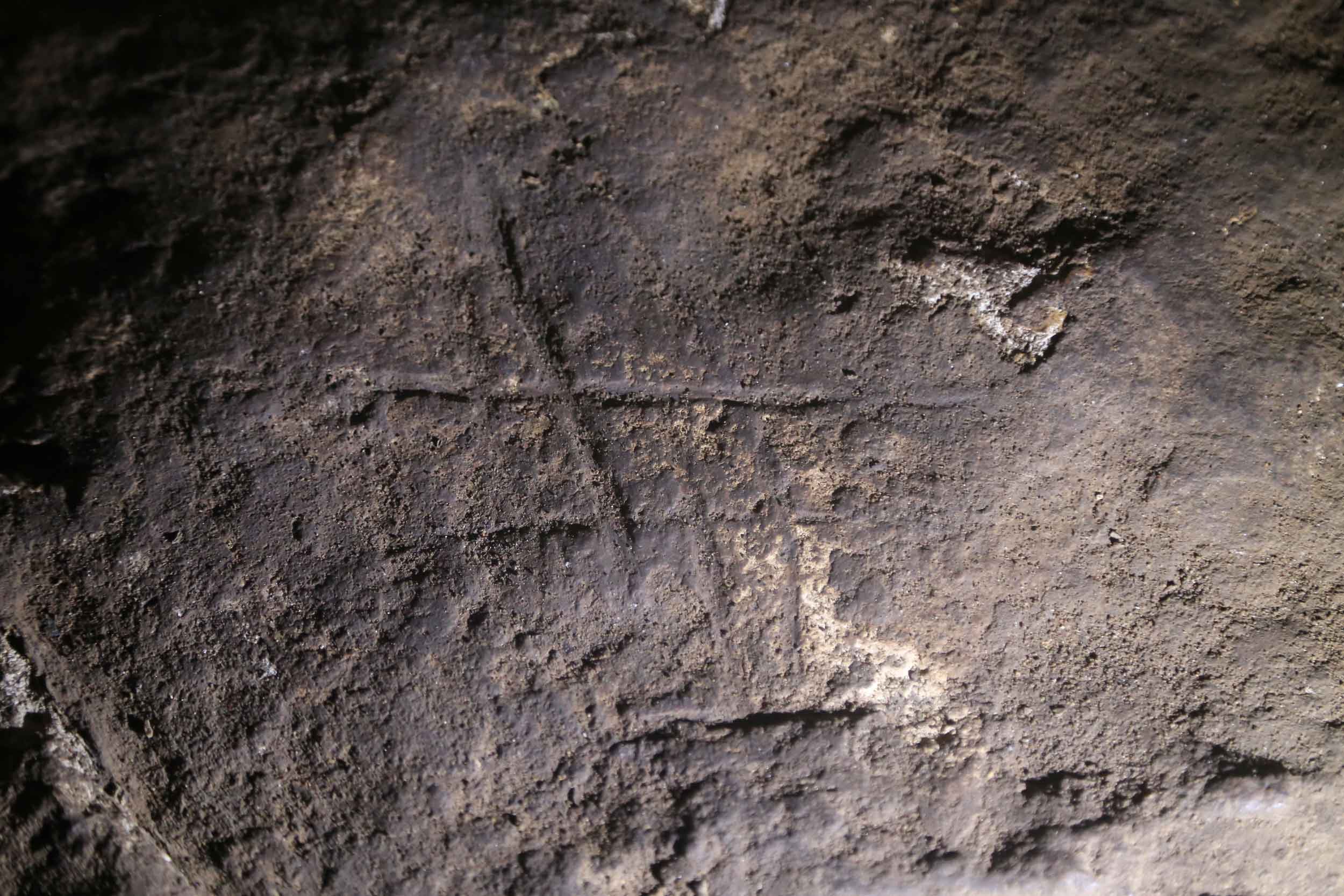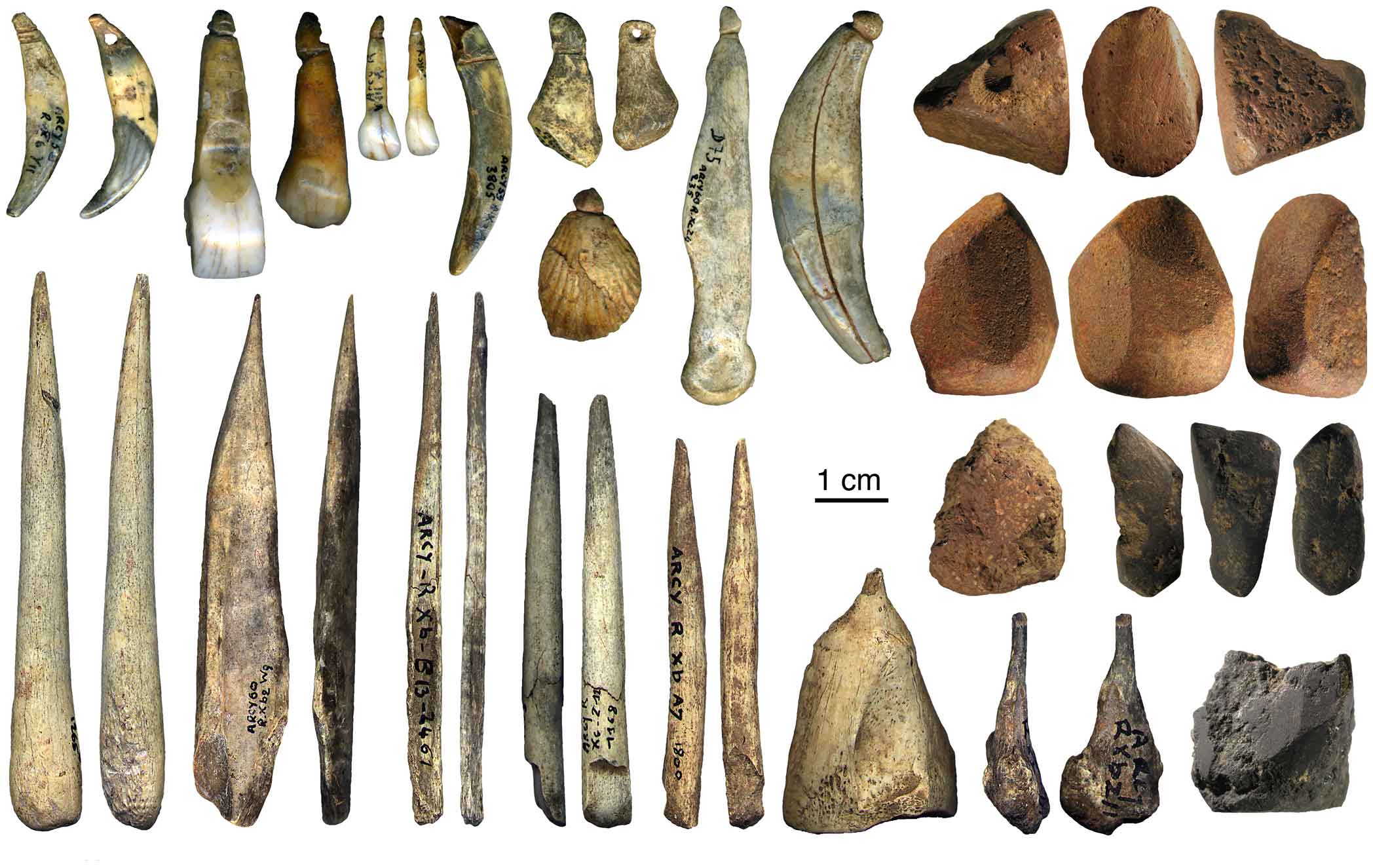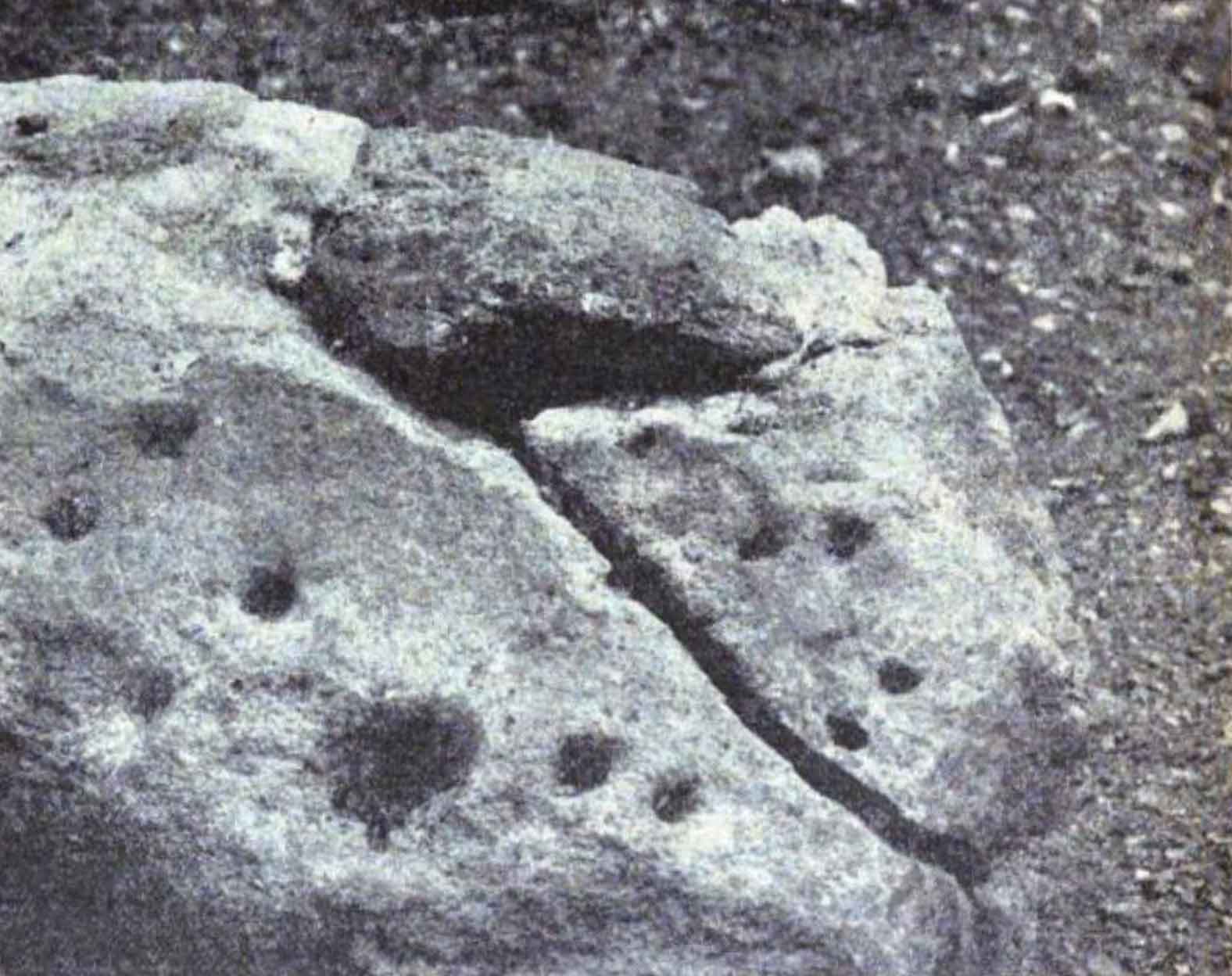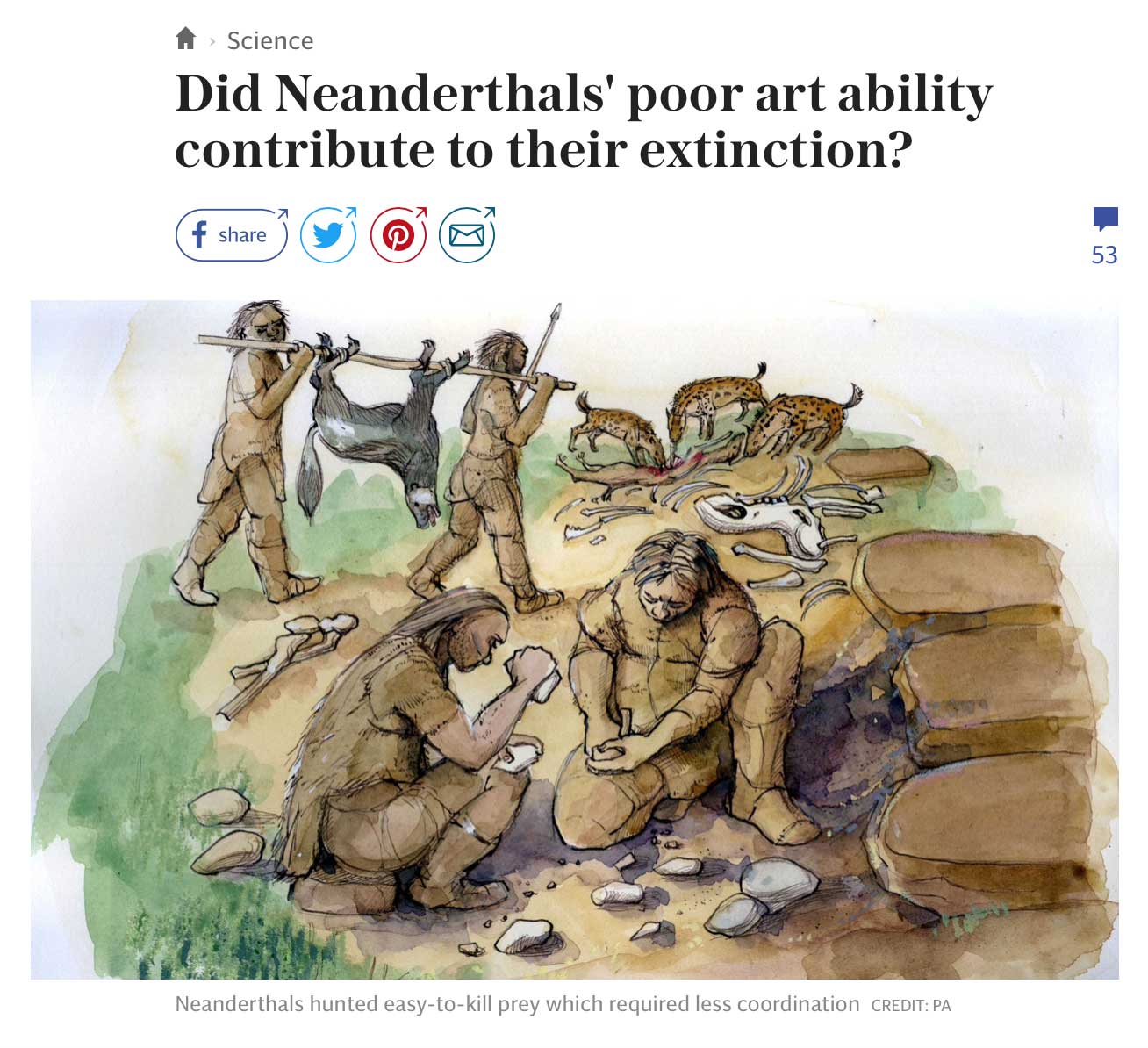Debates about Neandertal cave art miss the point of their visual culture
Humans today live in visually rich environments, and it's increasingly clear that Neandertals shaped their visual environments also.

Over roughly the last fifteen years, archaeologists and other scientists have uncovered much evidence of communicative use of objects and substances by Neandertals. Some of these ancient people used mineral pigments, some marked and engraved upon bones and rock surfaces, and some decorated themselves with objects like feathers or eagle talons. In 2018, a team led by the geochronologist Dirk Hoffmann showed that some red pigment markings from three caves in Spain were made earlier than 60,000 years ago. One of the dated markings is a handprint that had pigment applied around it. At that age, only Neandertals are known to have lived in Iberia, making this the first evidence that they were among the painters of caves.
To many anthropologists, this was one more piece of evidence of pigment use and visual culture of the Neandertals. But there were some strong critics of the research, first in Science where Hoffmann and coworkers had published their analysis, and then in other journals. Most focused upon the details of the uranium-thorium method of establishing the minimum ages of the markings. Most emphasized a common theme: that it is a “bold claim” that Neandertals made marks on some cave walls, which therefore requires “extreme caution”.
I've thought about this problem a lot, and really hesitated to write much about it until I came to understand it better. Many researchers clearly attribute very high significance to pigment marks on cave walls. In a 2019 comment on Hoffmann and colleagues' work, Randall White and collaborators emphasize the social role of art as a reason for their hesitation.
“Art is intimately dependent on the sociocultural context in which it is produced. So far, we have no proof that Neanderthal society needed a long-lasting means of communication to consolidate its values and beliefs.”—Randall White and collaborators
I think this is wrong. The evidence shows that visual culture was an important component of the social systems of many Neandertals. Archaeologists have found abundant physical evidence that they collected and worked mineral pigments. Sometimes they ground mineral pigments into powders which they mixed with liquid. Sometimes they marked on objects, including soft objects like hides or their own skin. Archaeologists have found many engraved bones at sites from Portugal to Crimea, and engraved markings including those on the floor of Gorham's Cave, in Gibraltar.

With all this evidence of visual culture, I don't see painting on cave walls as pivotal. But neither do I see it as a surprise. Some Neandertals probably walked through caves with their skin slathered in pigment, for goodness' sake. Leaving marks would have been natural for groups of people who routinely marked themselves and their ornaments. Besides, they had kids with them all the time. It would take a forensic cleaning squad to remove the signs that Neandertals had been there.
In 2009 I appeared in a documentary and said, “Neandertals have the mother of all image problems.” Nowhere is this so true as when it comes to the visual culture that they actually made.
The writer Judith Thurman in 2008 created a wonderful profile of the art historians and archaeologists working at Chauvet-Pont-d'Arc Cave, where some of the earliest cave art in France has been found. Like many articles, it emphasized the way that art illuminates the minds of modern people. This is how she described Neandertals:
“Later Neanderthal campsites have yielded some rings and awls carved from ivory, and painted or grooved bones and teeth (nothing of the like predates the arrival of Homo sapiens). The pathos of their workmanship—the attempt to copy something novel and marvellous by the dimming light of their existence—nearly makes you weep. And here, perhaps, the cruel notion that we call fashion, a coded expression of rivalry and desire, was born.”—Judith Thurman
This formulation was not a figment of a journalist's fancy; many archaeologists of the 1990s and early 2000s conceived Neandertals as defective imitations of “cognitively modern” people. In that era, archaeologists concerned with Neandertals staked out two starkly divergent ideas. Some thought that Neandertals had been acculturated into the production of ornaments and blade tools after contact with the “modern” populations who invented them. Others thought that Neandertals themselves had been inventors, developing traditions of visual culture on their own.
Nobody talks about Neandertal acculturation anymore. The evidence moved on past this debate. How that happened says a lot about the biases of the archaeological record.

Around the turn of the twenty-first century, evidence of pigments, ornaments, and blade manufacture by Neandertals appeared to be concentrated in so-called “transitional” archaeological assemblages, especially the Châtelperronian of France and northern Iberia. Châtelperronian sites, dating to between roughly 46,000 and 40,000 years ago, include many undeniably interesting artifacts that were part of Neandertal visual cultures, especially beads and pendants. The feel of Châtelperronian assemblages is Upper Paleolithic, including many bone tools and backed blades. Still, some archaeologists have noted that flaking methods in Châtelperronian assemblages resemble those in the Mousterian assemblages that preceded them, arguing for local technical development. The debate about Neandertal acculturation versus invention revolved around interpretations of this industry.
The Châtelperronian was controversial for two reasons. There was lingering uncertainty about the association of Neandertal skeletal remains with Châtelperronian artifact assemblages. Some of the most important sites—especially the Neandertal burial from Saint-Césaire, France—were the most problematic. Were the interesting artifacts really made by Neandertals? Even today some uncertainty continues, as archaeologists like Jean-Guillaume Bordes have written critically about the possible mixture of later and earlier artifacts into Châtelperronian assemblages.
The other problem was a question of originality. Châtelperronian assemblages occurred across roughly the same range of time as assemblages known as Early Aurignacian or Proto-Aurignacian. All of these could be found in the span between around 46,000 to 40,000 years ago, but never in the same place at the same time. Most archaeologists accepted that Aurignacian assemblages were made by populations who were not Neandertals, and although hardly any hominin fossils had been found in Early Aurigacian or Proto-Aurignacian contexts, the idea was that Aurignacian people were newcomers from the east who eventually would replace the Neandertals. Some archaeologists argued that the presence of this new, technologically sophisticated population would have spurred Neandertals to change their technologies. Maybe the Neandertals had learned to make ornaments, use pigments, and make bone tools and blades from these other people. This was the acculturation idea.
Looking back from today's perspective, both sides of this debate were forced to work with poor evidence. Today better ways of examining small fossil remains—especially teeth—as well as DNA evidence have helped to substantiate the timeline by which populations that originated in Africa eventually entered Europe. Early Aurignacian people were descendants of these Africans, and in central Europe some of the earliest immigrants before 36,000 years ago had a few recent Neandertal ancestors. Today's evidence supports that Neandertals made Châtelperronian assemblages. The finding of a possible non-Neandertal from Mandrin Cave, in southern France, as early as 50,000 years ago—a few thousand years before the Châtelperronian—suggests that earlier mixture or interactions may have happened.
Still, if today's data from these late Neandertals had been available twenty-five years ago, it may not have done much to persuade skeptical archaeologists about Neandertal authorship of visual culture. A comment by the late Paul Mellars helps to illustrate why:
“Purely at the level of statistics one would have to ask why a population which had maintained broadly the same pattern of technology over a period of 200,000–250,000 years should suddenly, coincidentally, and totally independently have devised a new pattern of typically Upper Palaeolithic technology at almost exactly the same time as anatomically and behaviourally modern populations are known to have been expanding across Europe.”—Paul Mellars
Mellars could hardly have expressed the stereotype any clearer: The Neandertals' stasis for a quarter million years attested enormous success within a limited niche. They never needed to change until faced with the challenge of Aurignacian people. Only at this extreme did they finally start something new.
This was an illusion. Over the decade following Mellars' article, archaeologists recognized more and more evidence of visual culture from Mousterian contexts, predating both the Châtelperronian and Aurignacian. Each new find seemed to ring a bell for other archaeologists, who then went to museum drawers and pulled out yet more evidence, often neglected or unrecognized after excavation decades earlier. Some of this evidence went back more than a hundred thousand years.
A memorable example is the recognition that Neandertals across Europe used feathers and talons from raptors in their visual culture. Examination of cutmarks on bird bones from a late Mousterian context at Fumane Cave, Italy, showed that the object had been feather and talon removal. This prompted a re-evaluation of museum collections in other parts of Europe. Bird exploitation turned out to be widespread across varied sites, and talons from eagles, falcons, and vultures were a common feature. This new research led Davorka Radovčić and collaborators to re-examine eagle talons from Krapina, Croatia, around 120,000 years old. On these fibers and cutmarks had remained unnoticed since their discovery more than a hundred years before.

A resurgence in study of pigment use by Neandertals was underway at the same time. Traces of pigments were identified on shells from Mousterian contexts, including at least one fossil shell from Italy and the outside of a geode from Romania. Archaeologists in the Netherlands uncovered a fine spatter of liquid hematite that early Neandertals had produced more than 200,000 years ago. Researchers began to investigate microscopic traces of abrasive wear on pieces of mineral pigments from Mousterian and Châtelperronian sites. Some had been ground into powder, others rubbed on soft surfaces like skin or hides.
All of these findings have unfolded within the last twenty years. But they're not really new in one important sense: They just add to a pattern of evidence about Mousterian pigments that began a hundred years before. The French prehistorian Denis Peyrony, who excavated many Mousterian and Upper Paleolithic sites in southern France, recognized pigment blocs in many Mousterian sites. He wrote in his 1923 text, Éléments de prehistoire:
“All the Mousterian deposits that I have excavated or visited have provided coloring matter consisting of poor quality red ocher and black manganese oxide, very abundant in some levels. Many pieces are scraped or polished by the use that has been made of them. What were these colors intended for? Probably to paint the face and the body; perhaps to draw on stone. It is to be hoped that subsequent discoveries will enlighten us on this subject.”—Denis Peyrony (my translation)
Peyrony was also part of the discovery at La Ferrassie of a stone with cupules, or engraved circular markings, associated with a Neandertal grave. Blocs of manganese dioxide and red ochre continued to be discovered at other Mousterian sites from the 1930s onward, recognized by François Bordes, Denise de Sonneville-Bordes, and other excavators.

The last twenty years of research have reawakened many archaeologists to the diversity of material evidence in the Neandertal record. The renewed examination of pigments, markings, and ornaments has been joined by a closer focus on implements like fiber and string, bone tools, and wooden tools. Research on the exploitation of marine mammals, shellfish, birds, and small mammals, as well as plant use, has also grown during this time.
In light of this history of research, it is hardly surprising that Neandertals left red marks on the walls of some caves. It echoes what Peyrony had thought was possible a hundred years ago.
Cave art is wonderful and awe-inspiring. I stood once in Font-de-Gaume, France, which is one of the few caves with figures of animals painted from blends of red and black pigments, mostly made by Magdalenian people around 18,000 years ago. It was impossible for me to look at the paintings of bison and reindeer and not consider what these must have meant to the people who made them. The experience of seeing the art, enduring through generations within dark imposing spaces, the bulges of the living rock creating their illusion of motion in the firelight, could not have been irrelevant to what the paintings meant to the ancient people who saw them.
But as wonderful as these paintings are, they are a small remnant of a much more extensive system that most people experienced through everyday items and interactions. We today live surrounded by rich visual cultures, which shape our interactions and belief systems. Few of us make enough art to be considered artists. Indeed, the subset of visual culture that today is recognized as art is a very tiny part of most of our interactions with each other.
By contrast, nearly everyone interacts with cosmetics in one way or another whenever they are around other people. We interact with geometric markings everytime we look at our phones. Some cultures historically have separated such varied elements of visual culture from them, classing them as different kinds of communication or behavior. Many have not. All of them are important to the way that people interact and communicate status, rank, and identity.

Neandertals were not all alike. Across more than 400,000 years and most of the western half of Eurasia, they had varied cultures and ways of life. In languages and visual cultures, they probably differed more they shared. But it is quite clear that many Neandertal groups made markings that would endure over time. Some of them used deep parts of caves, an experience that must have struck them physiologically in much the same way as later people. They made engravings in some of those places, far from natural light. Whatever they were communicating to each other surely mattered, and it occasionally endured.
Obviously, any single archaeological observation has to be rigorously tested and evaluated, and the geochronological assessment of pigment dots or handprints is no exception. I encourage readers to dig into that work and its critiques, because these show the state of the art.
But what amazes me is how far the state of the art has still to go. Back in 2011, Genevieve von Petzinger and April Nowell emphasized that the chronology of cave art in Europe has been based mainly on stylistic approaches, since less than 5 percent of the corpus had any geochronological work at all. Meanwhile, recent groundbreaking work by Maxime Aubert and many collaborators has shown that the earliest figurative art is in Sulawesi and Borneo. What we're seeing today is almost certainly just the beginning of a revised understanding of the chronology of rock art, and I expect it will be a very interesting road ahead.
Notes: The other day I looked back at a paper that I helped write back in 2004, to consider what I was thinking about Neandertal cultural evidence at that time. In the paper, titled “Why not the Neandertals?”, my collaborators and I reviewed anatomical, genetic, and cultural evidence of possible interactions between Neandertals and other populations. This was long before the recovery of ancient genomes which enabled the straightforward estimation of Neandertal ancestry in living people, and my part was to try to integrate the growing record of mitochondrial DNA from Neandertals and early Upper Paleolithic-associated humans. What struck me in the re-reading the paper is just how strongly we leaned upon the Châtelperronian evidence—because for the last fifteen years I've been giving lectures about Neandertal behavior without really referencing the Châtelperronian at all.
A post like this one, of course, can only scratch the surface. The phrase that I deliberately left out of this essay is “symbolic behavior”. I think it's meaningless. While I think more on that, I encourage readers to seek out Marc Kissel and Agustín Fuentes' work on the concept of “behavioral modernity”.
References
Bahn, P. G. (2010). Prehistoric Rock Art: Polemics and Progress. Cambridge University Press.
Brumm, A., Oktaviana, A. A., Burhan, B., Hakim, B., Lebe, R., Zhao, J., Sulistyarto, P. H., Ririmasse, M., Adhityatama, S., Sumantri, I., & Aubert, M. (2021). Oldest cave art found in Sulawesi. Science Advances, 7(3), eabd4648. https://doi.org/10.1126/sciadv.abd4648
Caron, F., d’Errico, F., Moral, P. D., Santos, F., & Zilhão, J. (2011). The Reality of Neandertal Symbolic Behavior at the Grotte du Renne, Arcy-sur-Cure, France. PLOS ONE, 6(6), e21545. https://doi.org/10.1371/journal.pone.0021545
Dayet, L., d’Errico, F., & Garcia-Moreno, R. (2014). Searching for consistencies in Châtelperronian pigment use. Journal of Archaeological Science, 44, 180–193. https://doi.org/10.1016/j.jas.2014.01.032
Dubow, S. (2019). Henri Breuil and the imagination of prehistory: “Mixing up rubble, trouble and stratification.” South African Archaeological Society Goodwin Series, 12, 31–43. https://doi.org/10.3316/informit.479413422318814
Hoffmann, D. L., Standish, C. D., García-Diez, M., Pettitt, P. B., Milton, J. A., Zilhão, J., Alcolea-González, J. J., Cantalejo-Duarte, P., Collado, H., de Balbín, R., Lorblanchet, M., Ramos-Muñoz, J., Weniger, G.-Ch., & Pike, A. W. G. (2018). U-Th dating of carbonate crusts reveals Neandertal origin of Iberian cave art. Science, 359(6378), 912–915. https://doi.org/10.1126/science.aap7778
Hoffmann, D. L., Standish, C. D., García-Diez, M., Pettitt, P. B., Milton, J. A., Zilhão, J., Alcolea-González, J. J., Cantalejo-Duarte, P., Collado, H., de Balbín, R., Lorblanchet, M., Ramos-Muñoz, J., Weniger, G.-Ch., & Pike, A. W. G. (2018). Response to Comment on “U-Th dating of carbonate crusts reveals Neandertal origin of Iberian cave art.” Science, 362(6411), eaau1736. https://doi.org/10.1126/science.aau1736
Hoffmann, D. L., Standish, C. D., García-Diez, M., Pettitt, P. B., Milton, J. A., Zilhão, J., Alcolea-González, J. J., Cantalejo-Duarte, P., Collado, H., de Balbín, R., Lorblanchet, M., Ramos-Muñoz, J., Weniger, G.-C., & Pike, A. W. G. (2020). Response to White et al.’s reply: ‘Still no archaeological evidence that Neanderthals created Iberian cave art’ [J. Hum. Evol. (2020) 102640]. Journal of Human Evolution, 144, 102810. https://doi.org/10.1016/j.jhevol.2020.102810
Kissel, M., & Fuentes, A. (2018). ‘Behavioral modernity’ as a process, not an event, in the human niche. Time and Mind, 11(2), 163–183. https://doi.org/10.1080/1751696X.2018.1469230
Leder, D., Hermann, R., Hüls, M., Russo, G., Hoelzmann, P., Nielbock, R., Böhner, U., Lehmann, J., Meier, M., Schwalb, A., Tröller-Reimer, A., Koddenberg, T., & Terberger, T. (2021). A 51,000-year-old engraved bone reveals Neanderthals’ capacity for symbolic behaviour. Nature Ecology & Evolution, 5(9), Article 9. https://doi.org/10.1038/s41559-021-01487-z
Marquet, J.-C., Lorblanchet, M., Egels, Y., Esquerre-Pourtère, J., & Hesse, M.-S. (2014). Les productions à caractère symbolique du site moustérien de La Roche-Cotard à Langeais (Indre-et-Loire, France) dans leur contexte géologique. PALEO. Revue d’archéologie préhistorique, 25, Article 25. https://doi.org/10.4000/paleo.2780
Mellars, P. (1999). The Neanderthal Problem Continued. Current Anthropology, 40(3), 341–364. https://doi.org/10.1086/200024
Peresani, M., Fiore, I., Gala, M., Romandini, M., & Tagliacozzo, A. (2011). Late Neandertals and the intentional removal of feathers as evidenced from bird bone taphonomy at Fumane Cave 44 ky B.P., Italy. Proceedings of the National Academy of Sciences, 108(10), 3888–3893. https://doi.org/10.1073/pnas.1016212108
von Petzinger, G., & Nowell, A. (2011). A question of style: Reconsidering the stylistic approach to dating Palaeolithic parietal art in France. Antiquity, 85(330), 1165–1183. https://doi.org/10.1017/S0003598X00061986
Peyrony, D. (1923). Éléments de prehistoire. G. Eyboulet.
Pike, A. W. G., Hoffmann, D. L., García-Diez, M., Pettitt, P. B., Alcolea, J., De Balbín, R., González-Sainz, C., de las Heras, C., Lasheras, J. A., Montes, R., & Zilhão, J. (2012). U-Series Dating of Paleolithic Art in 11 Caves in Spain. Science, 336(6087), 1409–1413. https://doi.org/10.1126/science.1219957
Pons-Branchu, E., Sanchidrián, J. L., Fontugne, M., Medina-Alcaide, M. Á., Quiles, A., Thil, F., & Valladas, H. (2020). U-series dating at Nerja cave reveal open system. Questioning the Neanderthal origin of Spanish rock art. Journal of Archaeological Science, 117, 105120. https://doi.org/10.1016/j.jas.2020.105120
Rodríguez-Vidal, J., d’Errico, F., Pacheco, F. G., Blasco, R., Rosell, J., Jennings, R. P., Queffelec, A., Finlayson, G., Fa, D. A., Gutiérrez López, J. M., Carrión, J. S., Negro, J. J., Finlayson, S., Cáceres, L. M., Bernal, M. A., Fernández Jiménez, S., & Finlayson, C. (2014). A rock engraving made by Neanderthals in Gibraltar. Proceedings of the National Academy of Sciences, 111(37), 13301–13306. https://doi.org/10.1073/pnas.1411529111
Slimak, L., Fietzke, J., Geneste, J.-M., & Ontañón, R. (2018). Comment on “U-Th dating of carbonate crusts reveals Neandertal origin of Iberian cave art.” Science, 361(6408), eaau1371. https://doi.org/10.1126/science.aau1371
Thurman, J. (2008, June 16). What Does the World’s Oldest Art Say About Us? The New Yorker. https://www.newyorker.com/magazine/2008/06/23/first-impressions
White, L. A. (1940). The Symbol: The Origin and Basis of Human Behavior. Philosophy of Science, 7(4), 451–463.
White, R., Bosinski, G., Bourrillon, R., Clottes, J., Conkey, M. W., Rodriguez, S. C., Cortés-Sánchez, M., de la Rasilla Vives, M., Delluc, B., Delluc, G., Feruglio, V., Floss, H., Foucher, P., Fritz, C., Fuentes, O., Garate, D., González Gómez, J., González-Morales, M. R., González-Pumariega Solis, M., … Willis, M. D. (2020). Still no archaeological evidence that Neanderthals created Iberian cave art. Journal of Human Evolution, 144, 102640. https://doi.org/10.1016/j.jhevol.2019.102640
Wolpoff, M., Mannheim, B., Mann, A., Hawks, J., Caspari, R., Rosenberg, K., Frayer, D., Gill, G., & Clark, G. (2004). Why not the Neandertals? World Archaeology, 36(4), 527–546. https://doi.org/10.1080/0043824042000303700
John Hawks Newsletter
Join the newsletter to receive the latest updates in your inbox.



